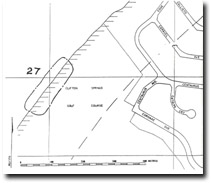27 Clifton Springs Jetty - Unconformity
|
This information has been developed from one or more of these publications:
|
| Location | 868748. Approximately 60 m north of the long derelict jetty at ‘The Dell’, Clifton Springs. | |
Access | Spring Street, Clifton Springs and road to “The Dell”. | |
Ownership/Managing Authority | Crown land (Port of Geelong Authority) below high water mark; private land above high water mark. | |
Site Description | The cliff base shows the unconformity between the Moorabool Viaduct Sand (here a strongly ferruginised conglomerate) and the Fyansford Formation (Curlewis Limestone). The conglomerate bands are lenticular and dip seawards. | |
Significance | Regional. The site shows a type of conglomerate ferruginisation at the base of the Moorabool Viaduct Sand. | |
Management Considerations | Class 1. The site should be left as natural exposure. No reclamation or protective structures should be built to obscure it. | |
References | Ladd, P.G. (1971) | |



